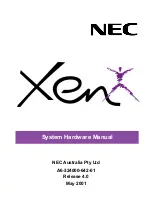
8
Attendant Overflow
Description
The G1/G2 Series Digital Telephone System lets you designate one station as a main answering position
or attendant console for incoming CO calls. If that station is busy, the system can select another station
which may act as a backup answering position. The system allows up to 15 backup positions behind
each attendant, for a possible total of 16 answering positions. There are three variations of Attendant
Overflow.
Linear Ringing
searches through the list of possible backup answering positions and will ring the first
available station. Free stations will be searched in the order programmed on Mode 01 (or 02 if Night
Service).
Circular Ringing
works like Linear Ringing except that it always begins its search immediately after the
last station that was rung.
Hunting
(Add-On) will ring the first available station. If the station does not answer within the time
parameter specified on the system, the system will "add on" the next available station. This timer will
repeat until the call is answered, abandoned or until every programmed available station is ringing.
Delayed Ring
is popular with many Voice Mail applications. In this mode, you may assign one or more
stations as primary answering positions. After a programmable period of time, the incoming call will be
diverted over to a hunt group which can contain voice mail ports used to answer incoming calls.
Automated Attendant functions may also be used as a means of Attendant Overflow. For more
information, please see Appendix A - DISA Detailed Explanation in this manual.
Conditions
The trunk must be programmed for Linear ringing if the Linear Overflow method of operation is preferred.
The trunk must be programmed for Hunt if the timed "add on" method of operation is desired.
Ringing Type is programmed on Mode 35-TK-07 for Day Service and Mode 35-TK-08 for Night Service.
Stations will be selected in the order they are programmed on the incoming ringing assignment Modes
(Mode 01-[TK]-[station] and Mode 02-[TK]-[STN]).
Program Ref Mode 35, Mode 01, Mode 02
Programming
Day Ringing Assignment, Mode 01-[TK]-[STN] must be programmed for each CO line in the system. Up
to sixteen stations may be programmed for each line on the G-Series. Lines programmed for Linear
Overflow or Hunt will search this Mode in the order that stations are programmed. The system will ring
the first available station in this group. This Mode controls ringing assignments during day service only.
Night Ringing Assignment, Mode 02-[TK]-[STN] is as listed above for Mode 01, but determines the
stations that will ring when the system is in Night Service.
Hunt Time Assignment, Mode 05-08-01 sets the interval for adding stations to the ringing sequence in a
no answer condition if Hunt is selected. Every time a station begins ringing, this timer will begin. If it
expires without the call having been answered, the next available station in the group defined on Mode
01-[TK]-[STN] or Mode 02-[TK}-[STN], whichever is applicable, will be added to the ringing sequence.
Valid settings for this option are:
Hunt Time Assignment, Mode 05-08-01
0=Disabled
1=2 seconds
2=4 seconds
3=6 seconds
4=8 seconds
5=15 seconds
6=30 seconds
7=60 seconds
8=120 seconds
9=4 seconds
Note:
If Mode 05-08-01 is set at 0 (disabled), CO line hunting will only occur on busy stations. The first
free station will be rung and the call will not add stations to the ringing sequence in a no-answer
condition.
Summary of Contents for G1 8-24
Page 191: ...191 DISA With No Voice Service Unit Chart 1 ...
Page 192: ...192 DISA With No Voice Service Unit Chart 2 ...
Page 193: ...193 DISA With No Voice Service Unit Chart 3 ...
Page 194: ...194 DISA With a Voice Service Unit Chart 1 ...
Page 195: ...195 DISA With a Voice Service Unit Chart 2 ...









































